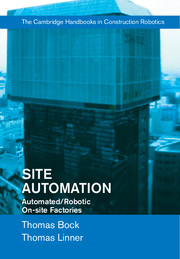Book contents
- Frontmatter
- Contents
- Acknowledgements
- Glossary
- 1 Integrated Automated/Robotic On-site Factories
- 2 Analysis and Categorization: Construction pages 8 to 144
- 2 Analysis and Categorization: Construction pages 145 to 256
- 3 Analysis and Categorization: Deconstruction
- 4 Conclusion: Discrepancy between Technical Capability and Efficiency
- References
- Index
3 - Analysis and Categorization: Deconstruction
Published online by Cambridge University Press: 05 April 2016
- Frontmatter
- Contents
- Acknowledgements
- Glossary
- 1 Integrated Automated/Robotic On-site Factories
- 2 Analysis and Categorization: Construction pages 8 to 144
- 2 Analysis and Categorization: Construction pages 145 to 256
- 3 Analysis and Categorization: Deconstruction
- 4 Conclusion: Discrepancy between Technical Capability and Efficiency
- References
- Index
Summary
Since 2008, when Kajima started the deconstruction era, the six major Japanese contractors had developed mechanized and partly automated deconstruction systems. Deconstruction systems follow the same approach as automated construction sites and install an on-site factory (fixed type or moving type), which then provides the basis for controlled, structured, and systematized on-site work processes. The cover of the on-site working area provides – apart from the advantage of creating a weatherproof and disassembly supportive environment (with the possibility of installing overhead cranes, cameras, and other measuring technology) – especially in building deconstruction, the advantage of being able to reduce the noise and dust disturbance to the surrounding environment (e.g., in the case of the TECOREP system, noise disturbance for the surrounding environment was reduced to less than 20 decibels). Deconstruction sites are work environments where processes are, in a factory-like manner, phased to a strict time schedule, and the flow of material is highly organized. Deconstruction sites thus follow the general idea of a structured environment (SE).
Deconstruction in Japan is a thriving market. As a result of to the growing population density, a huge number of high-rise buildings have been constructed since the early 1990s. Many of those high-rise buildings are no longer considered to be 100% fail-safe, owing to advanced knowledge of structural design and to a change in thinking and requirements after the March 2011 earthquake (magnitude: 9.0) and the predicted increase of earthquakes in the future. Developers and owners of those high-rise buildings thus have to consider either the (costly) integration of damping systems or the complete deconstruction and rebuild. The second method also has the potential benefit that during a rebuild, buildings can also be adapted to new functional, technological, and ecological requirements. This requires, however, that the deconstruction and rebuild can be done faster than with conventional methods. As the deconstruction and rebuild of high-rise buildings is a highly profitable business in Japan, and a huge amount of combined deconstruction/rebuild orders are expected over the next decade, major Japanese contractors are competing over deconstruction ability and speed.
- Type
- Chapter
- Information
- Site AutomationAutomated/Robotic On-Site Factories, pp. 257 - 298Publisher: Cambridge University PressPrint publication year: 2016



